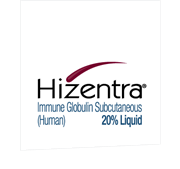- Prefilled Syringe Information
-
Physician Resources - Patient Resources
-
6 FILES
Patient Resources - Administration
-
2 FILES
Physician Resources - Referral and Support Services
-
5 FILES
Referral and Support Services - Boxed Warning
-
IMPORTANT SAFETY INFORMATION
WARNING: Thrombosis may occur with immune globulin products, including Hizentra. Risk factors may include: advanced age, prolonged immobilization, hypercoagulable conditions, history of venous or arterial thrombosis, use of estrogens, indwelling vascular catheters, hyperviscosity, and cardiovascular risk factors.
For patients at risk of thrombosis, administer Hizentra at the minimum dose and infusion rate practicable. Ensure adequate hydration in patients before administration. Monitor for signs and symptoms of thrombosis and assess blood viscosity in patients at risk for hyperviscosity.
- Highlights of Indications & Usage
-
INDICATIONS AND USAGE
Hizentra®, Immune Globulin Subcutaneous (Human), 20% Liquid, is indicated for:
- Treatment of primary immunodeficiency (PI) in adults and pediatric patients 2 years and older.
- Maintenance therapy in adults with chronic inflammatory demyelinating polyneuropathy (CIDP) to prevent relapse of neuromuscular disability and impairment.
-
- Limitation of Use: Maintenance therapy in CIDP has been systematically studied for 6 months and for a further 12 months in a follow-up study. Continued maintenance beyond these periods should be individualized based on patient response and need for continued therapy.
Please see full prescribing information for Hizentra including boxed warning.
- Highlights of Dosage & Administration
-
DOSAGE AND ADMINISTRATION
For subcutaneous infusion only.
Dose
PI
Before switching to HIZENTRA, obtain the patient’s serum IgG trough level to guide subsequent dose adjustments.
- Weekly: Start HIZENTRA 1 week after last Immune Globulin Intravenous (Human) (IGIV) infusion.
Initial weekly dose = Previous IGIV dose (in grams) x 1.37
No. of weeks between IGIV doses- Biweekly (every 2 weeks): Start HIZENTRA 1 or 2 weeks after the last IGIV infusion or 1 week after the last weekly IGSC infusion. Administer twice the calculated weekly dose.
- Frequent dosing (2 to 7 times per week): Start HIZENTRA 1 week after the last IGIV or IGSC infusion. Divide the calculated weekly dose by the desired number of times per week.
- Adjust the dose based on clinical response and serum lgG trough levels.
CIDP
- Initiate therapy with HIZENTRA 1 week after the last IGIV infusion.
- Recommended subcutaneous dose is 0.2 g/kg (1 mL/kg) body weight per week.
-
- In the clinical study after transitioning from IGIV to HIZENTRA, a dose of 0.4 g/kg (2 mL/kg) body weight per week was also safe and effective to prevent CIDP relapse.
- If CIDP symptoms worsen, on 0.2 g/kg (1 mL/kg) body weight per week, consider increasing the HIZENTRA dose from 0.2 g/kg to 0.4 g/kg body weight per week. If CIDP symptoms worsen on 0.4 g/kg body weight per week, consider re-initiating therapy with IGIV, while discontinuing HIZENTRA.
- Monitor patient’s clinical response and adjust duration of therapy based on patient need.
Administration
• PI: Administer at regular intervals from daily up to every 2 weeks.
• CIDP: Administer weekly.
• Infusion sites – Up to 8 infusion sites are allowed simultaneously, with at least 2 inches between sites.Administration in PI
Infusion Parameters* 1st Infusion Subsequent Infusions Volume (mL/site) ≤15 ≤25 Rate (mL/hr/site) ≤15 ≤25 *As tolerated
Administration in CIDP
Infusion Parameters* 1st Infusion Subsequent Infusions Volume (mL/site) ≤20 ≤50 Rate (mL/hr/site) ≤20 ≤50 *As tolerated
Please see full prescribing information for Hizentra including boxed warning.
Hizentra® is a registered trademark of CSL Behring AG.
Hizentra is manufactured by CSL Behring AG and distributed by CSL Behring LLC.
Information obtained from Hizentra®, Immune Globulin Subcutaneous (Human), 20% Liquid, by CSL Behring LLC.
HIZ-0038-OCT23
Please see
full prescribing information for Hizentra including boxed warning.
Indications and Important Safety Information
IMPORTANT
SAFETY INFORMATION
WARNING: Thrombosis may occur with immune globulin
products, including Hizentra. Risk factors may include: advanced age, prolonged
immobilization, hypercoagulable conditions, history of venous or arterial thrombosis,
use of estrogens, indwelling vascular catheters, hyperviscosity, and
cardiovascular risk factors.
For patients at risk of thrombosis, administer Hizentra at
the minimum dose and infusion rate practicable. Ensure adequate hydration in
patients before administration. Monitor for signs and symptoms of thrombosis
and assess blood viscosity in patients at risk for hyperviscosity.
Hizentra is
contraindicated in patients with a history of anaphylactic or severe systemic
reaction to human immune globulin (Ig) or components of Hizentra (eg,
polysorbate 80), as well as in patients with immunoglobulin A deficiency with
antibodies against IgA and a history of hypersensitivity. Because Hizentra
contains L-proline as stabilizer, use in patients with hyperprolinemia is
contraindicated.
IgA-deficient
patients with anti-IgA antibodies are at greater risk of severe
hypersensitivity and anaphylactic reactions. Thrombosis may occur following
treatment with Ig products, including Hizentra.
Monitor
patients for aseptic meningitis syndrome (AMS), which may occur following
treatment with Ig products, including Hizentra. In patients at risk of acute
renal failure, monitor renal function, including blood urea nitrogen, serum
creatinine and urine output. In addition, monitor patients for clinical signs
of hemolysis or pulmonary adverse reactions (eg, transfusion-related acute lung
injury [TRALI]).
Hizentra is
derived from human blood. The risk of transmission of infectious agents,
including viruses and, theoretically, the Creutzfeldt-Jakob disease (CJD) agent
and its variant (vCJD), cannot be completely eliminated.
The most common
adverse reactions (observed in ≥5% of study subjects) were local infusion-site
reactions, as well as headache, diarrhea, fatigue, back pain, nausea, extremity
pain, cough, upper respiratory tract infection, rash, pruritus, vomiting, upper
abdominal pain, migraine, arthralgia, pain, fall, and nasopharyngitis.
The passive transfer of antibodies can interfere with response to live virus vaccines and lead to misinterpretation of serologic test results.
Indications
Hizentra®,
Immune Globulin Subcutaneous (Human), 20% Liquid, is indicated for:
- Treatment of primary immunodeficiency (PI) in adults
and pediatric patients 2 years and older.
- Maintenance therapy in adults with chronic
inflammatory demyelinating polyneuropathy (CIDP) to prevent relapse of
neuromuscular disability and impairment.
- Limitation of Use: Maintenance therapy in CIDP has been systematically studied for 6 months and for a further 12 months in a follow-up study. Continued maintenance beyond these periods should be individualized based on patient response and need for continued therapy.
For
subcutaneous infusion only.
Please see full prescribing information for Hizentra including boxed warning.
To report
SUSPECTED ADVERSE REACTIONS, contact the CSL Behring Pharmacovigilance
Department at 1-866-915-6958 or FDA at 1-800-FDA-1088 or www.fda.gov/medwatch.

